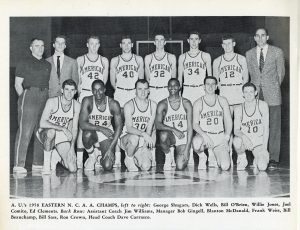AU will be celebrating its 22nd Campus Beautification Day on April 14th. This university tradition incorporates campus beautification and sustainability goals. Activities include planting, mulching, and installing rain barrels. In 2014, over 4,000 plants were planted on campus and students and staff volunteers participated in a community service project to remove bamboo debris from the Battery-Kemble Trail in Rock Creek Park.
Campus Beautification Day has deep roots at AU. Starting in 1933, AU students and faculty participated in campus cleanup projects in honor of Arbor Day. Classes were cancelled for the day. The morning was spent on a set of designated projects which ended with a picnic lunch. Afternoon activities included softball games and dancing. In addition to landscaping work, students and faculty built rock gardens and wooden bridges and installed benches and railings across campus. By the 1940s, students adopted the name “Campus Day” as the event was no longer always held on Arbor Day. When cleanup activities were held in conjunction with May Day festivities, the winner of the onion pulling contest was named court jester to the court of the spring queen. Campus Day continued through 1957.














